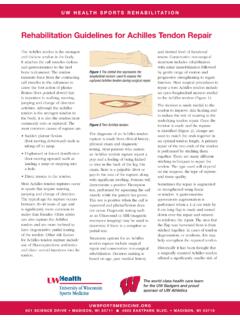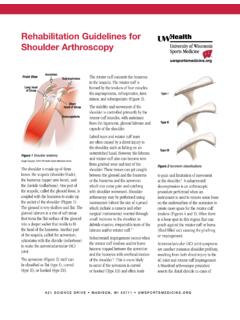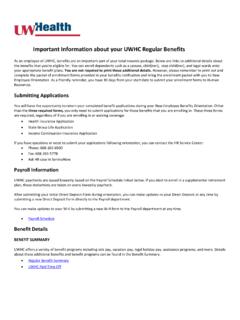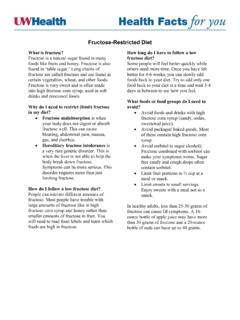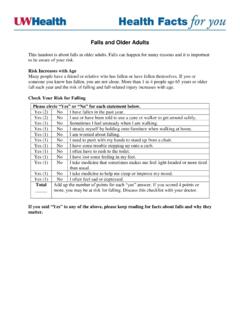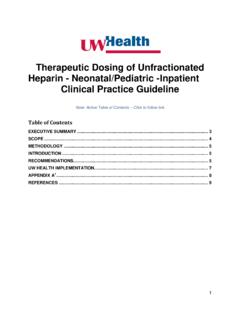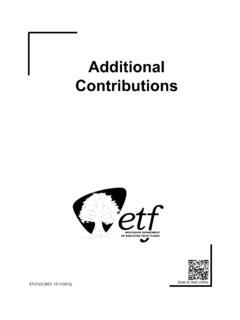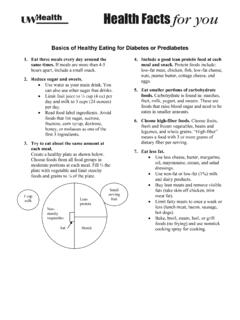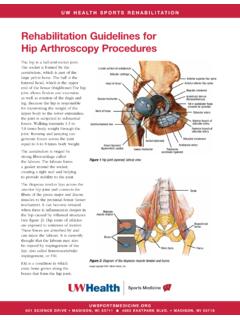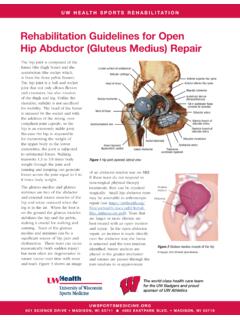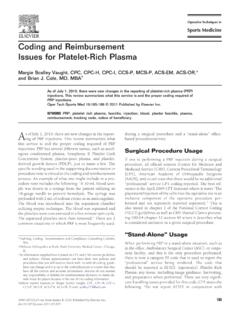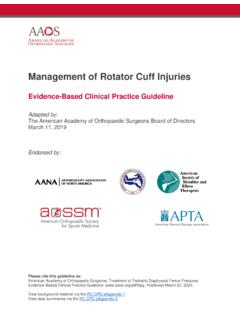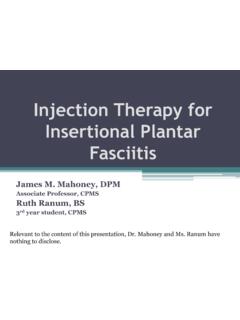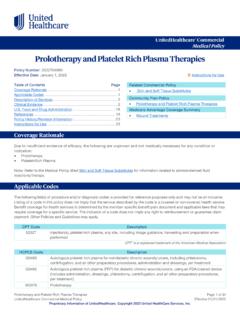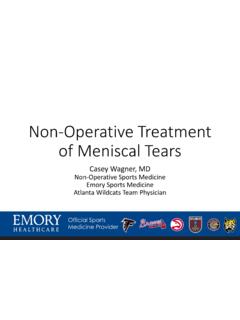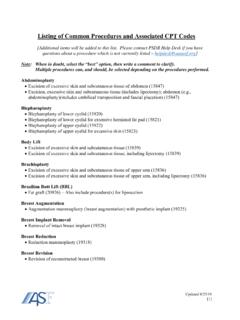Transcription of platelet-rich plasma rehabilitation guidelines
1 621 Science Drive MaDiSon, Wi 53711 HeaLtH SportS reHaBiLitationThe health care team for the UW Badgers and proud sponsor of UW Athleticsplatelet- rich plasma rehabilitation guidelinesWhat is tendinopathy?Tendons are strong bands of connective tissue comprised primarily of a substance called collagen. Mechanically, tendons connect muscle to bone and transmit the force to generate movement. Muscle and tendon injuries account for a significant percentage of the over 100 million physician visits in the US per year and this number will continue to rise as our population ages and remains active1. Previously, tendon injuries and disorders were almost always considered tendonitis.
2 Tendonitis is an inflammatory process, but recent research has shown that most of the more chronic tendon problems do not have any inflammatory cells. The primary problem in these cases appears to be a breakdown of the structural properties of the tendon collagen. Thus the correct terminology for this problem is tendinopathy, as opposed to results from overstressing a tendon. This can be from a singular acute bout of activity, or more often, from repetitive and sustained stresses over many months or even years. It is possible for different areas of the tendon to be in different stages of injury or disorder2.
3 Tendinopathy can ultimately lead to chronic degradation of the tendon, and rarely, to the point of tearing or rupture. There are many current treatment options for this condition including, but not limited to, rest, anti-inflammatory medications ( , ibuprofen, naproxen), steroid injections, physical therapy, shock wave therapy, dry needling and surgery. Recent advancements in regenerative (restoration and growth) medicine have led to the development of platelet - rich plasma (PRP) injections as a viable treatment for various is platelet - rich plasma (prp)?PRP is the concentration of platelets derived from the plasma portion of one s own blood3.
4 While platelets are widely known to play a large role in clotting processes, their use in treatment of tendon disease is due to their abundance of enzymes and growth factors related to the healing process4,5. Tendons have a poor blood supply, meaning it is difficult for these tissues to receive the nutrients needed to stimulate repair1,4,6. An injection of PRP to the injured site provides the tendon tissue with healing growth factors that are otherwise difficult for the body to deliver because of the poor blood supply. Similar mechanisms have been theorized for treatment of ligament injuries such as medial collateral ligament sprains of the knee or cartilage deterioration, such as osteoarthritis of the knee7.
5 The injection can also restart a healing inflammatory process, which is why patients are often given initial activity restrictions. Subsequent referrals to physical therapy are often made so that patients may be taught to load the tissue in an appropriate fashion to rebuild strength and flexibility. What does the prp procedure involve?PRP begins by collecting blood from the individual, usually by using a syringe and needle at the arm, similar to a clinic laboratory blood draw. The amount of blood needed is determined by the size of the area to be treated and the concentration of platelets desired3. The blood is then placed in a centrifuge where the rapid spinning process separates the blood into 3 components the plasma or water portion of the blood, the PRP layer, and the cellular layer containing red and white blood cells.
6 The PRP layer is then available for use in the clinic. After applying a local anesthetic (numbing medicine) to the site of the injection, the PRP is injected into the injured tissue. Sometimes the injection is performed in the radiology department so that the radiologist physician may view the area under ultrasound guidance to ensure accurate placement of the injection. The patient is educated about activity restrictions and is often given devices that limit the amount of movement at the area for the next few days. The patient is encouraged to rest the area for a few weeks, avoiding any vigorous or strenuous activities, before 621 Science Drive MaDiSon, Wi 53711 plasma rehabilitation guidelinesbeginning the rehabilitation process two weeks following the procedure.
7 The patient is typically seen by the physician in the clinic for routine follow-up about 1 month after the injection. Do i need to do physical therapy and rehabilitation after prp?A quality post-procedure rehabilitation program helps facilitate a successful outcome. Initial rehabilitation will focus on protection for healing and gentle range of motion. After the early phases, strengthening and neuromuscular control exercises are emphasized throughout the affected extremity. In the final stages of rehabilitation , the focus will be on progressive dynamic extremity control and stability during sport specific movements, such as change of direction and rotational movements.
8 The UW Health Sports Medicine rehabilitation guidelines below are presented in a criterion based progression. General time frames are given for reference to the average, but individual patients will progress at different rates depending on their age, associated injuries, pre-injury health status, rehabilitation compliance and injury severity. These guidelines are presented in reference to tendon-related procedures, but general guidelines and concepts apply with treatment of ligamentous, joint, and muscle Process:A: Collection of your own blood,B: Utilizing the centrifuge to separate the platelets and growth factors from the blood,C: The separation of components into 2 vials,D.
9 The injection of the platelet rich plasma to the affected Science Drive MaDiSon, Wi 53711 plasma rehabilitation guidelinespHaSe i (0 to 3 days after procedure)Appointments No appointments during this time as rehabilitation appointments begin 10-14 days after procedureGoals Protection of the affected tendon Pain controlPrecautions Immobilization of the affected joint: Sling for rotator cuff / biceps tendons Wrist splint for medial / lateral epicondyles Partial weight bearing with crutches for patellar / quadriceps tendons Partial weight bearing with crutches and walking boot for Achilles / ankle tendons Partial weight bearing with crutches and walking boot for plantar fasciaSuggested Therapeutic Exercises Gentle active range of motion (AROM) exercises out of the immobilizing deviceProgression Criteria 3 days after procedurepHaSe ii (3 to 10-14 days after procedure)
10 Appointments No appointments during this time as rehabilitation appointments begin 10-14 days after procedureGoals Increase tendon tolerance to daily activities Discontinue immobilizing devicePrecautions Weight bearing as tolerated, gradually weaning from assistive and immobilizaing devices No overstressing of the tendon through exercise, lifting, or impact activitySuggested Therapeutic Exercises Continue with active range of motion exercises out of the device 3 times a day for 5 minutes a session. This will be described for you at your physician clinic visit. Lower body exercise for upper body procedures and upper body exercise for lower body procedures are allowed.
